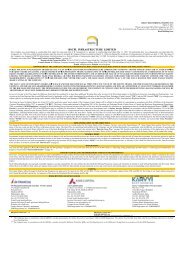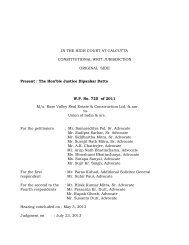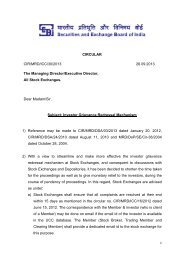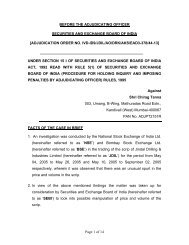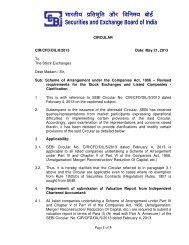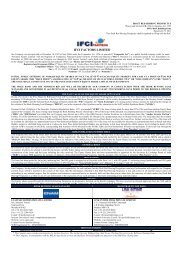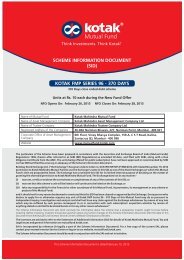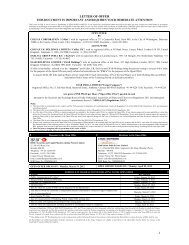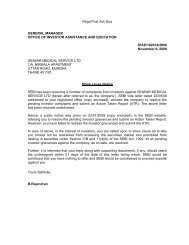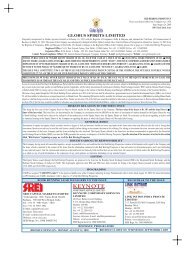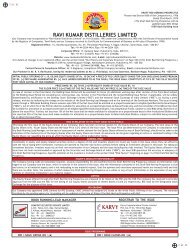KAMDHENU ISPAT LIMITED - Securities and Exchange Board of India
KAMDHENU ISPAT LIMITED - Securities and Exchange Board of India
KAMDHENU ISPAT LIMITED - Securities and Exchange Board of India
Create successful ePaper yourself
Turn your PDF publications into a flip-book with our unique Google optimized e-Paper software.
· In China <strong>and</strong> other Asian countries, dem<strong>and</strong> is led by emphatic investment activities in infrastructure.<br />
· Russia <strong>and</strong> other CIS nations are also witnessing strong internal dem<strong>and</strong>.<br />
· Iraq reconstruction work is expected to fuel further dem<strong>and</strong> for steel over the next three years.<br />
· China is consuming steel for its infrastructure with investments such as the “Three Gorges Project” on Yangtze<br />
River as well as to build up infrastructure for Beijing Olympics in 2008 <strong>and</strong> the Shanghai Expo in 2010.<br />
The dem<strong>and</strong> supply gap is expected to increase <strong>and</strong> will drive steel prices north, even as the global steel industry is<br />
not prepared for this dem<strong>and</strong> onslaught.<br />
Local Factors<br />
The <strong>India</strong>n government believes that <strong>India</strong> will become a developed nation by 2020 with a per capita GDP <strong>of</strong><br />
USD1540. Steel industry will play a leading role in achieving this target. Steel is poised for growth with abundant iron<br />
ore resources <strong>and</strong> an established base for steel production in <strong>India</strong>. Production has already increased from 13.4 Mn<br />
tones in 1991-92 to 38.4 Mn tones in 2004-05. While steel will continue to have a stronghold in traditional sectors<br />
such as construction, housing <strong>and</strong> ground transportation, special steels will be increasingly used in hi-tech engineering<br />
industries such as power generation, petro chemicals, <strong>and</strong> fertilizers. Steel will continue to be the most popular,<br />
versatile <strong>and</strong> dominant material used in wide ranging applications. In fact, analysts have forecast that the <strong>India</strong>n<br />
steel sector will continue to witness growth in the next few years backed by domestic drivers such as infrastructure<br />
<strong>and</strong> automobile dem<strong>and</strong>. The abysmally low per capita consumption <strong>of</strong> steel at 20 kilograms (kg) in <strong>India</strong> as compared<br />
with global majors will primarily drive dem<strong>and</strong><br />
The continued thrust on infrastructure <strong>and</strong> related activities <strong>and</strong> their extension to rural <strong>India</strong> will provide a tremendous<br />
boost to the steel industry. This will require huge material <strong>and</strong> capital infusions. The union budget for 2003-04<br />
provided a major thrust through innovative funding mechanisms. The initiative covers:<br />
· 48 new road projects at an estimated cost <strong>of</strong> Rs.400, 000mn; with a quarter <strong>of</strong> the roads being concretized,<br />
· National Rail Vikas Yojana projects worth Rs.80, 000mn;<br />
· Renovation/modernization <strong>of</strong> two airports <strong>and</strong> two seaports at an estimated cost <strong>of</strong> Rs.110, 000mn,<br />
· Establishing two international convention centres at global st<strong>and</strong>ard for an estimated cost <strong>of</strong> Rs.10, 000mn.<br />
The total cost <strong>of</strong> these projects is estimated at Rs.600, 000mn. In addition, the budget also announced funding for<br />
the North-South <strong>and</strong> East-West corridors. This would provide a further Rs.26,000mn for highway development.<br />
However, there may be a slowdown in the export markets in the coming months, partly due to additional capacities<br />
in China going on-stream <strong>and</strong> the possibility <strong>of</strong> further trade actions in the US <strong>and</strong> the European Union restricting<br />
imports from <strong>India</strong>.<br />
D. Conclusion<br />
Steel Products: Forecasted Parent Consumption/Dem<strong>and</strong><br />
(‘000 tonnes)<br />
2005-06 2006-07 2007-08 2008-09 2009-10<br />
Longs (Regression with GDP method)<br />
Bars <strong>and</strong> Rods 12214 12879 13593 14471 15465<br />
Structurals<br />
Flats (End use method)<br />
3064 3252 3432 3654 3904<br />
HR Plates 3061 3284 3500 3730 3974<br />
HR Coils 11930 12865 13873 14960 16132<br />
CR Coils 6256 6672 7117 7591 8096<br />
GP/GC 2068 2153 2241 2333 2429<br />
Source: CRIS INFAC<br />
As we can see, the consumption pattern <strong>of</strong> steel, especially <strong>of</strong> long products, will remain on an upward trajectory<br />
riding the back <strong>of</strong> increased spending on all construction <strong>and</strong> infrastructure related activities.<br />
Economic growth is a key driver for steel industry growth. However, the government too spends substantial amounts<br />
on infrastructure related activities irrespective <strong>of</strong> the state <strong>of</strong> the economy. In fact, historically the government has<br />
upped its spending in the recessionary phases to generate employment <strong>and</strong> increase disposable incomes in the<br />
h<strong>and</strong>s <strong>of</strong> the people.<br />
Increased spending on infrastructure will drive the steel sector – resulting in a boost for dem<strong>and</strong> for steel . The<br />
government has announced a total outlay <strong>of</strong> USD.13bn spread over a few years to develop roads, rails, airports <strong>and</strong><br />
39



